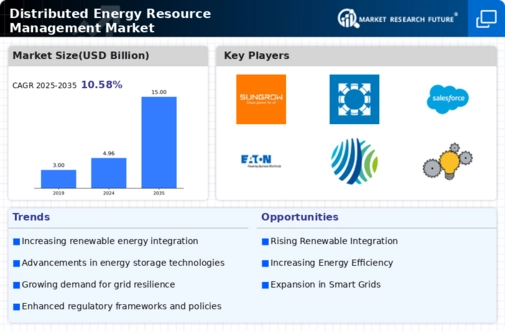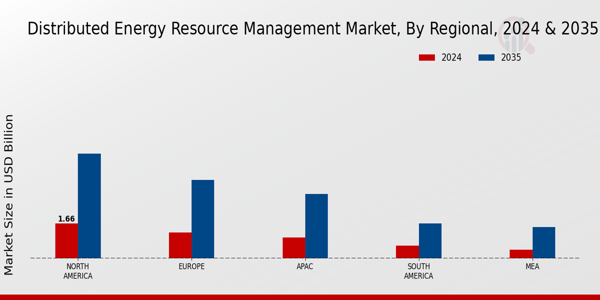Market Analysis
Distributed Energy Resource Management (Global, 2024)
Introduction
D. The D. E. R. M. market is undergoing a major transformation as the world's energy system moves towards greater sustainability and resilience. With the growing integration of distributed energy resources such as solar and wind power, and the development of energy storage, the management of distributed energy resources has become an important issue for utilities, regulators and consumers. This report explains the key drivers shaping the D. E. R. M. market, including regulatory frameworks, technological innovations and the growing demand for decentralized energy solutions. As energy users and producers seek to optimize energy production and consumption while maintaining the stability of the grid, the D. E. R. M. market is expected to play a pivotal role in the transition towards a more decentralized and efficient energy system. It is essential that industry participants understand the market's dynamics if they are to take advantage of the opportunities presented by the ongoing energy transition.
PESTLE Analysis
- Political
- In 2024, the market for distributed energy resources management (DERM) will be largely influenced by government policies promoting the use of renewable energy. In the United States, the Inflation Reduction Act of 2005 allocates approximately $370 billion to support the development of clean energy, which also includes distributed energy resources. Moreover, some states have implemented so-called renewable portfolio standards (RPS), requiring utilities to obtain a certain percentage of their energy from renewable sources. For example, in California, it is mandatory that by 2030, at least 60% of the electricity will be provided by renewable sources.
- Economic
- The economic factors influencing the DERM market in 2024 are the rising costs of the conventional energy sources and the falling costs of the new energy sources. For example, the cost of solar photovoltaic systems has fallen by about 89% since 2010. This has made them more accessible to consumers and businesses. In addition, in 2023, the world investment in renewable energy sources reached $ 495 billion. This reflects a strong economic shift towards sustainable energy solutions, which will continue to influence the DERM market.
- Social
- In America, the public is becoming more and more accepting of the idea of renewable energy sources, with more than 75 per cent of the population in favour of increasing the use of solar and wind energy. The demand for distributed energy resources is rising as communities seek to reduce their carbon footprint and increase their energy independence. As well as the growth of community solar, where several households benefit from a single solar installation, the number of people using such schemes has risen sharply, with more than two million people participating by 2024.
- Technological
- The DERM market is driven by technological innovation. The efficiency and reliability of distributed energy systems have been improved by technological innovations in energy storage and smart grids. Energy storage is expected to be worth $ 20 billion by 2024, with growth driven by the increasing deployment of batteries that enable the better integration of intermittent renewable sources. And the growing use of the Internet of Things in energy management systems will improve the real-time monitoring and control of distributed energy resources and make energy use more efficient.
- Legal
- The legal framework regulating the DERS market is evolving, and new regulations are being developed to encourage the integration of DERS into the grid. In 2024, a new rule proposed by the Federal Energy Regulatory Commission (FERC) would require the electricity companies to allow the wholesale markets to access the DERS, which could increase the market access of DERS. In addition, a number of states have introduced net metering, which allows consumers to be credited for the surplus electricity they generate from their DERS, which also encourages their use.
- Environmental
- The environment is a major factor in the DERM market, especially with climate change and the need for sustainable energy solutions. By 2024, it is estimated that the energy sector will be responsible for approximately 73% of global greenhouse gas emissions. There is a strong demand for a transition to cleaner energy sources. In the energy sector, DERM is seen as a key strategy for reducing CO2 emissions. It has been estimated that increasing the share of renewables in the energy mix could lead to a reduction of up to 70 % in CO2 emissions by 2050.
Porter's Five Forces
- Threat of New Entrants
- The DERS market in 2024 faces a moderate threat of new entrants. The DERS market is growing due to the increasing demand for renewable energy and energy efficiency, but the initial capital investment and the required technical skills can be considerable barriers to entry. Also, the established players have a strong brand and customer loyalty, which makes it difficult for new entrants. However, technological development and favorable government policies can encourage new entrants.
- Bargaining Power of Suppliers
- The suppliers in the DERS market generally have low bargaining power. Suppliers offer a variety of components and technology, reducing the dependence on a single supplier. Also, the increasing availability of alternative components and materials makes it easy to change suppliers, reducing supplier power.
- Bargaining Power of Buyers
- The buyers are in a position of power because they have more choice than ever. Distributed energy resources are on the rise, and with them the number of suppliers and solutions on the market is growing, thereby increasing competition among the suppliers. This allows the buyers to negotiate better prices and conditions and strengthens their position in the market.
- Threat of Substitutes
- The threat of substitutes in the market for DERS is moderate. There are energy solutions such as fossil fuels and centralized energy systems. But the trend towards the use of sustainable and green energy sources is driving the demand for distributed energy resources. The presence of established energy sources can still be a threat, especially in regions where the use of renewable energy sources is less developed.
- Competitive Rivalry
- Competition is high in the distributed energy resource management market, as numerous players compete for market share. The market’s rapid growth has attracted both incumbents and new entrants, and this has intensified competition. To differentiate their products and services, companies are constantly improving their offerings. This has also increased competition. The trend towards sustainability and the changing regulatory environment are also driving competition.
SWOT Analysis
Strengths
- Increased adoption of renewable energy sources leading to a diverse energy mix.
- Enhanced grid reliability and resilience through decentralized energy management.
- Technological advancements in energy storage and smart grid solutions.
Weaknesses
- High initial investment costs for infrastructure and technology.
- Complex regulatory environment that may hinder market growth.
- Limited consumer awareness and understanding of distributed energy resources.
Opportunities
- Growing demand for energy independence and sustainability among consumers.
- Government incentives and policies promoting renewable energy adoption.
- Potential for integration with electric vehicles and smart home technologies.
Threats
- Intense competition from traditional energy providers and emerging technologies.
- Regulatory changes that could impact market dynamics and profitability.
- Cybersecurity risks associated with increased digitalization of energy systems.
Summary
The distributed energy resource management market in 2024 is characterized by significant strengths such as the increasing use of renewable energy and technological advances, which are improving grid reliability. But the high initial costs and regulatory complexities may hamper growth. There are many opportunities in the form of increasing demand for sustainable energy solutions and government support. Threats from competition and cyber risks are looming. Strategic planning is required to take advantage of strengths and opportunities and to minimize threats and weaknesses.















Leave a Comment